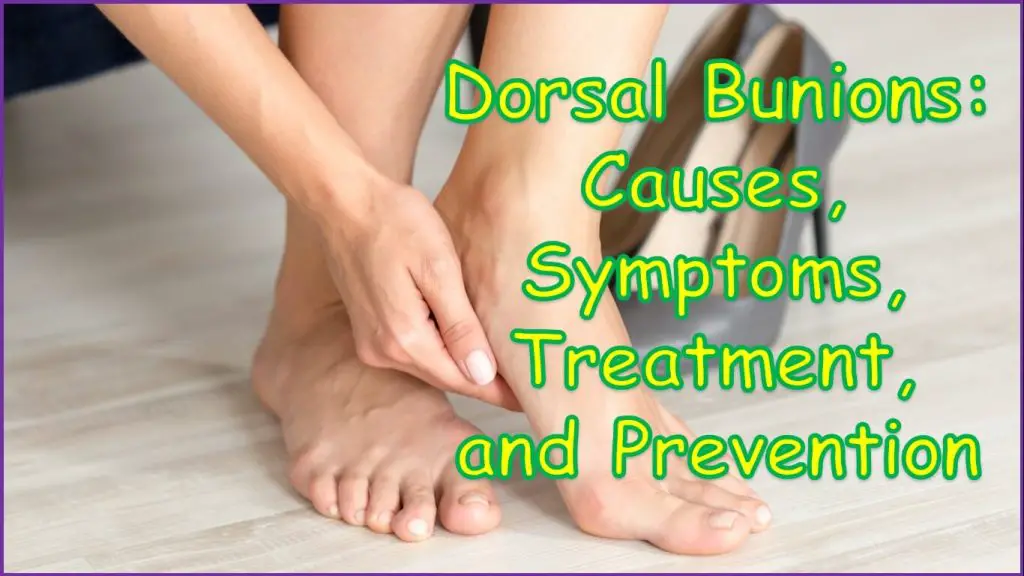Experiencing tenderness or discomfort on the upper side of your foot near your big toe’s base? You may be suffering from dorsal bunions. Dorsal bunions, also called dorsal exostosis or osteochondromas, are a common foot ailment causing significant discomfort and pain.
In this article, we’ll delve into the causes, symptoms, treatment, and prevention of dorsal bunions to help you comprehend this condition better and provide relief.
What Are Dorsal Bunions?
Dorsal bunions are a type of bunion developing on the foot’s upper side, rather than on the side. Typically caused by excessive growth of bone in the metatarsal bone, linking the toes to the ankle. Several factors can cause this excessive growth of bone, such as genetics, trauma, repeated pressure, and irritation on the foot.
Causes Of Dorsal Bunions
Dorsal bunions can arise from multiple factors. Here are some of the common reasons:
Genetics:
Dorsal bunions can be hereditary, so if you have a family history of bunions, you may be at higher risk of developing dorsal bunions.
Trauma:
Foot injuries can cause dorsal bunions to develop.
Footwear:
Tight or narrow shoes put pressure on the foot’s upper side, causing dorsal bunions.
Occupation:
Standing or wearing tight shoes for long periods may increase the risk of developing dorsal bunions.
Rheumatoid Arthritis:
People with rheumatoid arthritis are more likely to develop dorsal bunions due to joint inflammation and deformity.
Symptoms Of Dorsal Bunions
Symptoms of dorsal bunions vary from person to person. The most common symptoms are:
- Pain or tenderness on the upper side of the foot, near the big toe’s base
- Redness or swelling around the affected area
- Difficulty wearing shoes or walking comfortably
- Limited joint mobility
Diagnosis Of Dorsal Bunions
To diagnose dorsal bunions, doctors or podiatrists will perform a physical examination of the foot and might order X-rays or other imaging tests for better bone structure analysis. An accurate diagnosis is essential for developing an effective treatment plan.
Treatment Of Dorsal Bunions:
The severity of the condition and experienced symptoms determine the treatment of dorsal bunions. Non-surgical treatments can help relieve mild to moderate symptoms, while more severe cases may require surgery.
Non-surgical Treatments For Dorsal Bunions:
Changing footwear:
Wearing shoes that fit properly and have a wide toe box can help reduce pressure on the upper side of the foot. You can find them here: Best Shoes for Bunions and Hammer Toes
Padding or taping:
Cushioning the affected area with padding or tape can reduce pain and discomfort. You can find them here: Best Pain Relief Pads for Bunions
Orthotics:
Custom shoe inserts can relieve the pain and discomfort caused by dorsal bunions.
Surgical Treatment For Dorsal Bunions:
Surgical treatments for dorsal bunions are recommended for severe cases or if non-surgical treatments are not effective. Surgery involves removing the excessive bone growth and realigning the toe joint.
Prevention Of Dorsal Bunions
Prevention of dorsal bunions is possible by following some simple steps:
- Wearing properly fitting shoes with a wide toe box
- Avoiding tight or narrow shoes
- Taking regular breaks if your occupation requires standing or wearing tight shoes
- Maintaining a healthy weight to reduce pressure on the feet
Final Thoughts
Dorsal bunions can cause significant pain and discomfort, but with proper diagnosis and treatment, relief is possible. Follow the preventative measures mentioned above to avoid developing dorsal bunions. [read more]
See Also:
- Bunion surgery recovery week by week
- 4 weeks after bunion surgery
- Best shoes for ankle support
- Best bunion corrector
- Gout vs bunion
- What to expect 3 weeks after bunion surgery
- Lapiplasty bunion surgery pros and cons
- Heels for flat feet
- How to get rid of tailor’s bunion without surgery
- Can Bunions Cause Foot Cramps?
- Can Bunions Cause Arch Pain?
- Can Bunions Cause Ankle Pain?
- Best shoes for ingrown toenails
- Can Bunions Cause Foot Swelling on Top of Foot?
- Can Bunions Cause Back Pain
- Can Bunions Cause Knee Pain?
- Can Bunions Cause Sciatica?
